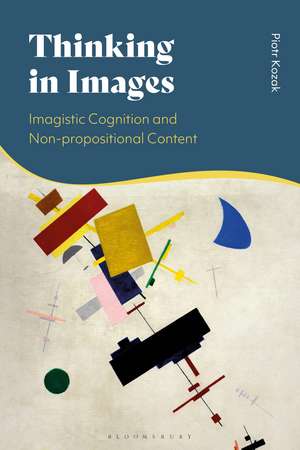Thinking in Images: Imagistic Cognition and Non-propositional Content
Autor Piotr Kozaken Limba Engleză Hardback – 17 mai 2023
Preț: 510.68 lei
Preț vechi: 731.35 lei
-30% Nou
Puncte Express: 766
Preț estimativ în valută:
97.73€ • 101.41$ • 81.69£
97.73€ • 101.41$ • 81.69£
Carte tipărită la comandă
Livrare economică 17-31 martie
Preluare comenzi: 021 569.72.76
Specificații
ISBN-13: 9781350267466
ISBN-10: 1350267465
Pagini: 248
Ilustrații: 20 bw illus
Dimensiuni: 156 x 234 x 21 mm
Greutate: 0.52 kg
Editura: Bloomsbury Publishing
Colecția Bloomsbury Academic
Locul publicării:London, United Kingdom
ISBN-10: 1350267465
Pagini: 248
Ilustrații: 20 bw illus
Dimensiuni: 156 x 234 x 21 mm
Greutate: 0.52 kg
Editura: Bloomsbury Publishing
Colecția Bloomsbury Academic
Locul publicării:London, United Kingdom
Caracteristici
Provides a detailed philosophical analysis of imagistic thinking, drawing on insights from philosophy of science, picture-theory, cognitive science and cognitive psychology
Notă biografică
Piotr Kozak is Assistant Professor at the Institute of Philosophy, University of Bialystok, Poland.
Cuprins
List of FiguresAcknowledgmentsIntroduction 1. What is the Problem of Thinking with Images?2. What is Thinking? 3. What Answers Should We Expect?4. What Do Images Do?5. Recognition-based Identification6. What is an Image?7. Thinking with Images8. ConclusionNotesReferencesIndex
Recenzii
Piotr Kozak's book is the first systematic exploration of the far-reaching consequences of imagistic cognition: our ability to use mental imagery in our thinking and problem-solving. I expect - and certainly hope - that it will be the go-to book on imagistic cognition in the years to come.
Thinking in Images demonstrates the cognitive role of images, or iconic representations, in rational thinking. Kozak responds to skeptics by showing that images are indispensable for thinking as measuring devices, even if they are not propositional. Drawing on measurement theory, he provides a novel account of image contents.
How many windows are in your home? One way to answer is to imagine your home and count the windows. Such imagistic thinking abounds in art and science, but how does it work? Thinking in Images answers by arguing images are measuring devices - less like sentences and more like rulers.
Thinking in Images demonstrates the cognitive role of images, or iconic representations, in rational thinking. Kozak responds to skeptics by showing that images are indispensable for thinking as measuring devices, even if they are not propositional. Drawing on measurement theory, he provides a novel account of image contents.
How many windows are in your home? One way to answer is to imagine your home and count the windows. Such imagistic thinking abounds in art and science, but how does it work? Thinking in Images answers by arguing images are measuring devices - less like sentences and more like rulers.
